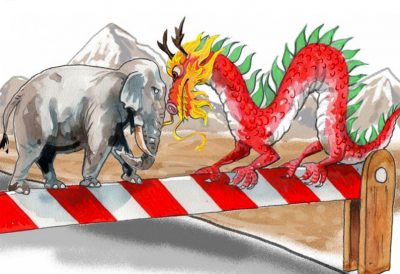China and India Increase Mutual Violence

Tensions have risen sharply on the China-India border. The two countries – which have the largest populations and the largest armies in the world, as well as nuclear weapons – started a recent conflict in the Himalayas, causing the death of dozens of people, recovering the scene of violence experienced in the early 1960s when both entered a war for the same reason, from which China emerged victorious.
In early May, tensions in the region increased after the Indian press said Chinese forces had set up tents, dug trenches and transported heavy equipment several kilometers into what India considered its territory. The move came after India built hundreds of kilometers’ road into access to a high-altitude air base. India blamed China for the situation. The case worsened after approximately 250 soldiers from both nations clashed on the night of May 5, in the Pangong lake area, leaving more than 100 wounded on both sides. The confrontation only ended after a meeting between local leaders.
“During the ongoing process in the Galwan valley, a violent confrontation occurred (…) with victims on both sides,” says an official statement from the Indian Army. China, meanwhile, asked India “not to take unilateral action or create problems”, and China’s Foreign Ministry spokesman, Zhao Lijian, said it was India, not China, that crossed over the border, “provoking and attacking the Chinese people, resulting in serious physical confrontation between border forces on both sides”.
The confrontation of narratives is a striking feature in conflict scenarios. But, in fact, while one government accuses the other, people die in clashes that could be avoided. In 1993 and 1996, China and India signed agreements on peacekeeping in disputed regions. India accuses China of violating the terms of these agreements. This is already the biggest clash between both countries since the end of the Sino-Indian war in 1962.
From all perspectives, a new war between India and China would be disastrous, not just for the Kashmir region, but for the whole world, which would deal with the risk of a nuclear war. A “small” nuclear war in the region would be enough to drastically reduce the world capacity for food production and circulation, in addition to causing a major migratory crisis and, consequently, political dissatisfaction in all affected countries. Still, China and India are members of the BRICS group and, in theory, this means that both countries should maintain friendly and mutual cooperation relations, aiming to increase their emerging powers at the dawn of a multipolar world. A war between two BRICS members is the worst case scenario for the group and the damage could be irreversible.
Still, there is no worse time for a war than a global pandemic scenario. However, international tensions around the world only tend to increase as the media coverage of the virus serves as an excellent excuse to ignore military movements and attacks. In the midst of the pandemic, some conflicts have been escalated, which is definitely a serious strategic blow for any country.
The West did not take long to try to assert its interests in the region. In late May, American President Donald Trump expressed an interest in “mediating” peace between both countries – he was the only head of state in the world who volunteered to do so. In his account on a social network, the American president wrote: “We have informed both India and China that the United States is ready, willing and able to mediate or arbitrate their now raging border dispute. Thank you!”. Trump’s readiness to guarantee peace in Asia is curious when the same president vehemently accuses China of creating the new coronavirus, which leads us to the question: is it really the peace that the United States wants to negotiate in Kashmir?
A war between China and India would benefit the West, destabilizing two great emerging powers with great growth potential, delaying the multipolar agenda. However, both countries are demonstrating their sovereignty and their ability to reach peace agreements without any outside interference. After a long meeting, the chancellors of China and India agreed to reduce the violence immediately, not going ahead with the possibility of war.
Although tensions are far from over and the border remains occupied by the military, China and India show a willingness to negotiate peace and, even more, a true sovereign attitude, dispensing with US mediation and arbitration and initiating independent talks, in which the chances of reaching an agreement are higher than with Washington trying to impose its agenda.
*
Note to readers: please click the share buttons above or below. Forward this article to your email lists. Crosspost on your blog site, internet forums. etc.
This article was originally published on InfoBrics.
Lucas Leiroz is a research fellow in international law at the Federal University of Rio de Janeiro.
Featured image is from InfoBrics

